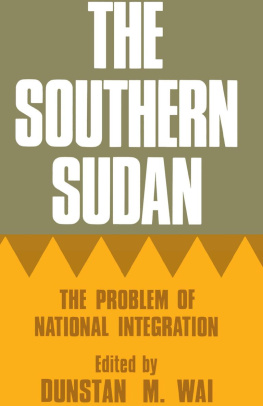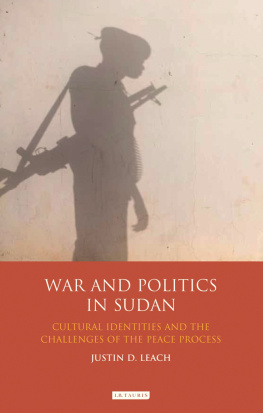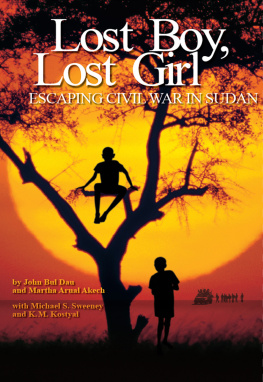First published 2006 by Transaction Publishers
Published 2017 by Routledge
2 Park Square, Milton Park, Abingdon, Oxon OX14 4RN
711 Third Avenue, New York, NY 10017, USA
Routledge is an imprint of the Taylor & Francis Group, an informa business
Copyright 1975 by The Shiloah Center for Middle Eastern and African Studies, Tel Aviv University, Israel.
All rights reserved. No part of this book may be reprinted or reproduced or utilised in any form or by any electronic, mechanical, or other means, now known or hereafter invented, including photocopying and recording, or in any information storage or retrieval system, without permission in writing from the publishers.
Notice:
Product or corporate names may be trademarks or registered trademarks, and are used only for identification and explanation without intent to infringe.
Library of Congress Catalog Number: 2005044772
Library of Congress Cataloging-in-Publication Data
Collins, Robert O., 1933
The southern Sudan in historical perspective/Robert O. Collins.
p. cm.
Originally published: Tel Aviv: The Shiloah Center, 1975.
ISBN 1-4128-0585-6 (pbk.: alk. paper)
1. SudanHistory. I. Title.
DT108.7.C64 2006
962.9dc22 2005044772
ISBN 13: 978-1-4128-0585-8 (pbk)
Many centuries ago, perhaps before the birth of Christ, a Negroid people entered the Nile Valley from the west, probably bringing with them the Sudanic agricultural complex. Although moving eastward to the Ethiopian escarpment, these Negroid peoples did not at the time migrate south up the Nile Valley where the land of swamps and water was ill-suited to the West African crops they cultivated but remained in the central Bahr al-Ghazal as a relatively small agricultural group. Sometime after the first millennium of the Christian era they developed a pastoral complex which was either combined with their Sudanic agriculture or sustained with little or no dependence on the soil. Where or how these people, called Nilotes, adopted the cattle complex is unknown. They may have borrowed milking techniques from the Cushiticspeaking peoples of the Ethiopian Highlands or more indirectly from the Beja or developed pastoralism independently.
Once having learned to subsist by pastoral nomadism, however, the Nilotes achieved a mobility which their former agricultural existence had prevented, and in the fifteenth century they began to expand from their cradleland in the central Bahr al-Ghazl. One group, which became the Dinka and the Nuer, moved but a short distance to the swampy grasslands north and east of the Nilotic heartland. Here they remained as a homogeneous people, tending their cattle alone and isolated. Their minimal grovernment satisfactorily dealt with internal disputes, and the absence of external threats made the evolution of more centralized institutions of authority unnecessary.
A second body of Nilotes appear to have penetrated, perhaps at an earlier time, east of the Bar al-Jabal where they were deflected southward by the sparse grazing immediately west of Lake Rudolf. They infiltrated down the rift valley into Kenya, occupied at that time by Cushitic people who had lived in the highlands of East Africa since high antiquity. These Nilotes overwhelmed and absorbed the Cushites but in turn adopted many Cushitic customs and language traits. Their descendants, the Masai, the Nandi, the Karamojong, and the Jie, inhabit these areas today, practicing many Cushitic customs and their language reflecting Cushitic influence.
In the fifteenth century yet a third group of Nilotes, the Luo, began to migrate from the Bahr al-Ghazl. The Luo marched south and east toward the Bar al-Jabal, moving undoubtedly like other Nilotic immigrants in small clusters of clan and lineage. Before crossing the Bar al-Jabal one such group left the main body and struck off to the north. This group in turn appears to have suffered defections during the northward march. The Bor made their way west to the ironstone plateau south of Wau. Another group led by Gilo also disengaged from the main body, marched north and east to the Sobat River, and made their way upstream to their present location at the base of the Ethiopian escarpment. They are known today as the Anuak. Some eight or ten generations ago in the seventeenth century a splinter group moved south from the Anuak country to Lafon Hill where they were called the Pari, while a second clan, the Pajook, penetrated southward into Acholi territory in northern Uganda.
Meanwhile, the original party, which was traditionally composed of only a few families, continued northward to Wipac in the vicinity of Lake No under the leadership of two brothers, Nyikango and Dimo. Here, as a result of a quarrel, Dimo and his followers departed to the south and west to settle eventually in the vicinity of Wau where the neighboring Dinka gave them their present name Jur meaning stranger. His numbers now diminished, Nyikango migrated northeastwards, absorbing, undoubtedly to strengthen his little band, many non-Luo during the march. The son and successor of Nyikango, Dak, ultimately settled along the White Nile after defeating and assimilating non-Luo inhabitants. Thereafter the Shilluk, as they were called, dominated the White Nile until the mid-nineteenth century.
West of the Nilotes of the Bar al-Ghazl live the Njangulgule and the Shatt who speak a language of the Eastern Sudanic subfamily but not of the Nilotic branch. South of the Njangulgule and the Shatt dwell the Kreish near the Congo-Nile Divide. The Kreish and the Bongo of the Bar alGhazl and the Moru-Madi group in Equatoria all speak Central Sudanic languages. Originally these Central Sudanic-speaking peoples lived further to the west in the vast area south of Lake Chad from which they were pushed south and east by waves of migrants following behind them. On the one hand, the Kreish appear to have been the north wing of this wave of Sudanic immigrants and were driven across the Congo-Nile Divide into the western Bar al-Ghazl. The Bongo and the Moru on the other seem to have moved south into the Uele Basin where, finding the great Equatorial rainforest an impenetrable obstacle, they were forced by the steady pressure of fresh waves of invaders to move northeastward into the Southern Sudan. Following the successive waves of Central Sudanic-speaking tribes into the Southern Sudan were invaders speaking languages of an entirely different family, the Niger-Congo linguistic group and particularly the subfamily called Adamawa-Eastern. The first Africans speaking languages of the Adamawa-Eastern subfamily to cross the Congo-Nile Divide appear to have been a host of small tribes which settled on the fringe of the Nilotes. Never possessing the power of a large population these tribes soon found themselves hopelessly compressed between the Dinka confederation and the fresh waves of the Azande who, speaking a language of the Adamawa-Eastern subfamily, followed their predecessors into the Southern Sudan.
The first of the Azande waves probably reached the Mbomu River sometime in the sixteenth century and were followed by yet other waves of Azande migrants moving eastwards. None of these inundations acted as a unifying agent, and the various Azande groups intermingled in the Mbomu valley in a confused pattern of weak, local authorities with conflicting claims and rival loyalties. In the middle of the eighteenth century a new group of invaders, the Avungara, crossed into the valley of the Mbomu from the Shinko River. The Avungara differed from their predecessors. A proud and military aristocracy, they imposed their authority on the multitude of Azanda-speaking peoples, creating from their absorption the great Zande empire.









